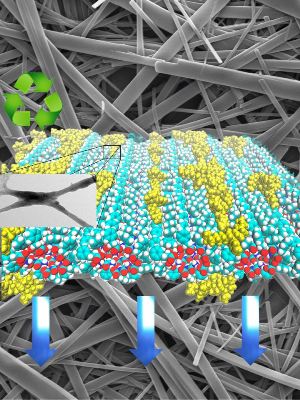Researchers from the University of Missouri are working on a method for manufacturing biodegradable electronics with the use of organic components found in mobile phone screen displays, which will help to reduce the amount of electronic waste entering landfills across the world.
 The illustration shows a theoretical simulation of the distribution of the polymer on peptide nanotubes and an electron microscopy image of the nanocomposite.
The illustration shows a theoretical simulation of the distribution of the polymer on peptide nanotubes and an electron microscopy image of the nanocomposite.
According to World Health Organization reports, even minimal exposure to disposed electronic elements can pose a health hazard. In the U.S alone, people generally dispose of their mobile phones every two years, resulting in over 150 million phones per year getting dumped into landfills.
“Current mobile phones and electronics are not biodegradable and create significant waste when they’re disposed,” said Suchismita Guha, professor in the Department of Physics and Astronomy at the MU College of Arts and Science. “This discovery creates the first biodegradable active layer in organic electronics, meaning—in principle—we can eventually achieve full biodegradability.”
In close cooperation with Soma Khanra, a graduate student, and a research group from the Federal University of ABC (UFABC), Brazil, Guha created organic structures with the capability of lighting handheld device screens. Guha’s team used proteins or peptides to prove that when integrated with a blue light-emitting polymer, these miniature structures could be effectively applied in displays.
“These peptides can self-assemble into beautiful nanostructures or nanotubes, and, for us, the main goal has been to use these nanotubes as templates for other materials,” Guha said. “By combining organic semiconductors with nanomaterials, we were able to create the blue light needed for a display. However, in order to make a workable screen for your mobile phone or other displays, we’ll need to show similar success with red and green light-emitting polymers.”
Furthermore, the team observed that using peptide nanostructures helped to reduce the amount of polymer required. That it is possible to produce the same blue light using less polymer indicates that the nanocomposites could realize nearly 85% biodegradability.
“By using peptide nanostructures, which are 100% biodegradable, to create the template for the active layer for the polymers, we are able to understand how electronics themselves can be more biodegradable,” Guha said. “This research is the first step and the first demonstration of using such biology to improve electronics.”
The research paper, titled “Self-Assembled Peptide-Polyfluorene Nanocomposites for Biodegradable Organic Electronics”, was published in Advanced Materials Interfaces. The National Science Foundation (Grant IIA-1339011) and CNPq (400239/2014-0) supported this research.
Other contributors to the research were assistant research professor of biochemistry Tommi White, and Thomas Lam, belonging to the Microscopy Core Research Facility at MU. Other collaborators include Wendel A. Alves and Thiago Cipriano, professors of supramolecular chemistry at UFABC; Eudes E. Fileti, a professor of physics at the Federal University of São Paulo, Brazil.